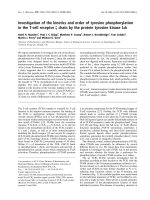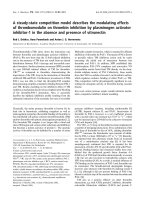The throws and takedowns of judo by geoff thompson
Bạn đang xem bản rút gọn của tài liệu. Xem và tải ngay bản đầy đủ của tài liệu tại đây (1.24 MB, 96 trang )
The Throws and Take-downs of
Judo
Geoff Thompson
SUMMERSDALE
Copyright © Geoff Thompson 2001
All rights reserved. The right of Geoff Thompson to be
identified as the author of this work has been asserted in
accordance with the Copyright, Designs and Patents Act of
1988.
No part of this book may be reproduced by any means, nor
translated into a machine language, without the written
permission of the publisher.
Summersdale Publishers Ltd
46 West Street
Chichester
West Sussex
PO19 1RP
United Kingdom
www.summersdale.com
Printed and bound in Great Britain.
ISBN 1 84024 026 1
First edit by Kerry Thompson.
Photographs by David W. Monks, member of the Master Photographers’ Association
Snappy Snaps Portrait Studio
7 Cross Cheaping
Coventry
CV1 1HF
Important note
If you have or believe you may have a medical condition the
techniques outlined in this book should not be attempted
without first consulting your doctor. Some of the techniques
in this book require a high level of fitness and suppleness and
should not be attempted by someone lacking such fitness.
The author and the publishers cannot accept any responsibility
for any proceedings or prosecutions brought or instituted
against any person or body as a result of the use or misuse of
any techniques described in this book or any loss, injury or
damage caused thereby.
About the author
Geoff Thompson has written over 20 books and is known
worldwide for his bestselling autobiography, Watch My Back,
about his nine years working as a nightclub doorman. He
currently has a quarter of a million books in print. He holds
the rank of 6th Dan black belt in Japanese karate, 1st Dan in
judo and is also qualified to senior instructor level in various
other forms of wrestling and martial arts. He has several
scripts for stage and screen in development with Destiny
Films.
He has published articles for GQ magazine, and has also been
featured in FHM, Maxim, Arena, Front and Loaded magazines,
and has appeared many times on mainstream television.
Geoff is currently a contributing editor for Men’s Fitness
magazine.
Geoff was trained in judo by British judo champion Wayne
Lakin and Olympic silver medallist Neil Adams OBE; he spent
18 months as a full-time judo student in Neil Adams’
international class in Coventry, England. He qualified as a black
belt with the BJA under the legendary judoka Alan
Petherbridge 9th Dan OBE.
Thank you to Wayne Lakin for years of private tuition and friendship, also to
Neil Adams for allowing me into his elite full-time class. Thank you to all the
lads at Neil’s for looking after me and for being patient. Also to the legendary
Alan Petherbridge OBE for taking me under his wing.
For a free colour brochure of Geoff Thompson’s
books and videos please ring the
24-hour hotline on 02476 431100 or write to:
Geoff Thompson Ltd
PO Box 307
Coventry
CV3 2YP
www.geoffthompson.com
www.summersdale.com
Contents
Introduction
10
Chapter One: Balance, Stance, Grip
17
Chapter Two: Taiotoshi (Body Drop)
26
Chapter Three: Ippon Shionagi (Shoulder Throw)
33
Chapter Four: Ogoshi (Hip Throw)
40
Chapter Five: Osoto Gari (Major Outside Reap)
46
Chapter Six: Ouchi Gari (Major Inside Reap)
54
Chapter Seven: Kouchi Gari (Minor Inside Reap)
60
Chapter Eight: Harai Goshi (Sweeping Hip Throw) 66
Chapter Nine: Uchimata (Inner Thigh Throw)
72
Chapter Ten: Hiza Garuma (Knee Wheel)
78
Conclusion
84
Judo
Introduction
There has been a lot said of late about the art of grappling or,
more specifically, the art of ground fighting. The grappling
arts are enjoying a well-earned and long-awaited revival.
Grappling was in vogue in the early part of this century, a
period known as the Golden Age of Wrestling, but it
popularity waned just before – and probably due to – the
Great War, only to be reborn post-war as ‘show grappling’.
It would seem that grappling has always lain hidden within
the shadow of contemporary combat, probably due to its
unembellished demeanour. Its devastating potency is often
hidden (to the uninitiated) by its lack of obvious aesthetic;
people have been drawn instead to the superfluously
spectacular kicking arts. However, the world of combat, and
more specifically the world of martial arts, has now evolved
and many of the more spectacular systems have failed the
acid test of time and the pressure test of reality. They have
crumbled under the weight of contemporary violence like a
paper house in a hurricane. The prettier systems that originally
G E O F F
10
T H O M P S O N ’ S
T H R O W S
A N D
T A K E - D O W N S
Introduction
drew thousands like summer moths to a flame have balked
at the obstacle of practicality, proving to be little more than
showy glitz. The fundamental movements of the grappling
arts, so often ignored due to the ‘ugly duckling’ syndrome,
have risen above the maelstrom; the swan of real combat
has blossomed leaving the ‘flash’ dead in the water.
Due to the well-publicised rise of the UFC (Ultimate Fight
Competition) – cage fighting, reality combat and extreme
fighting, everybody suddenly wants to fight on the floor, often
to the detriment of all other ranges. I can understand this,
ground grappling has been missing from martial arts for so
long, and the UFC-type tournaments advertise grappling
supremacy so well, it is only natural that people want to fill
their baskets with the ‘missing range’. Suddenly everyone (and
his dog) is desperate to make up for their lack and learn the
art of ground fighting. And so they should. I’ve been trying to
tell people this for the last ten years. Having worked as a
nightclub doorman for nine years I always knew that grappling
was a vital part of the martial armoury. But this is where the
G E O F F
T H O M P S O N ’ S
T H R O W S
A N D
T A K E - D O W N S
11
Judo
problems begin. Whilst it is important, even imperative to
include grappling on the curriculum it should not be to the
exclusion of the other ranges. Martial artists are abandoning
their base style to become grapplers. This will do little more
than move their weak link from one section of the martial
chain to another. They become very good at the match-fight
scenario where grapplers rule supreme, but wholly
inadequate when it comes to anything involving the other
ranges.
My speciality is adapting combat techniques to the street
scenario, making it work outside the chip shop and for streetdefence, specifically 3-second fighting and ambush fighting.
Grappling can be very weak in this arena due to the four B’s:
biting, butting, blinding and buddies. You have to know
grappling of course; you need a map around all of the combat
ranges even if it is only to enable you to avoid the traps, but
don’t make this one range – or any range for that matter –
your be all and end all. I have become a good grappler so that
I can anti-grapple, and in a worst-case scenario so that I can
G E O F F
12
T H O M P S O N ’ S
T H R O W S
A N D
T A K E - D O W N S
Introduction
escape from a bad position on the floor should I make a
mistake and find myself there. The fighter who becomes a
great grappler because he has watched the reality tapes can
find himself getting punched out in the bar by a 3-second
fighter, or kicked to death by a football fan with not a single
day of formal martial arts to his name. So let’s keep things in
context. Grapple, yes; but never neglect the other ranges
that make up the armoury. If one range is neglected then you
have a chink in the armour; you may be judged in a real
situation on the strength of that one range, as they say, you
are only as strong as your weakest link.
Equally with the ground-fighting phenomenon there has been
little or no notice taken of the tachi waza, or standing
techniques. A lot of what happens on the floor (unless you
are an exceptional ground fighter) is wholly determined by
how you got there. If you are thrown, dragged, kicked or
punched to the floor and end up in a bad position you may
never escape, or your opponent may be in a position to stand
back up and kick pieces off you while you are on your back.
G E O F F
T H O M P S O N ’ S
T H R O W S
A N D
T A K E - D O W N S
13
Judo
When we practise ground fighting we start from a neutral
position. Both fighters with an equal start. In a real situation
there is no such neutrality and you very much have to make
the best of what you are given, that is unless you are the one
who controls the take-down. The question that I always ask
when watching demos of ground fighting prowess is, ‘Yeah,
but how do you get to that position from vertical fighting?’
Thus my quest to learn the throws and take-downs from as
many systems as possible began.
In this volume we will look specifically at the basic throws
and take-downs of judo. Having studied this system for quite
a chunk of my life I can vouch for the potency and dynamism
of this much-underrated art.
As with ground fighting, don’t make the throws and takedowns the be all and end all. Many opponents in a live scenario
will not allow you to throw them cleanly, they will grip you
like their very lives depend upon it and drag you to the floor
G E O F F
14
T H O M P S O N ’ S
T H R O W S
A N D
T A K E - D O W N S
Introduction
with them and if you don’t know how to fight on the floor
then you are up the proverbial creek.
As I have said in all of the books and videos that I put out,
please don’t rely on this book, or any other for that matter,
to teach you, it must be used in combination with a good
class or a good training partner. There is nothing like a real
opponent to perfect the physical technique; I’d go as far as to
say that it cannot be learned properly by book alone. Learn
the fundamentals of the technique, and then put it under the
pressure of a non-compliant partner to perfect it. Once you
can work the technique on someone that doesn’t want to be
thrown, then you know you’ve got it off.
Compliance kills!
Compliance in training is only of use when first learning the
fundamentals of a technique; once learned, an opponent
should offer 100 per cent resistance. Taking the randori (freefighting or sparring) out of a system is effectively taking the
G E O F F
T H O M P S O N ’ S
T H R O W S
A N D
T A K E - D O W N S
15
Judo
teeth out of it. If there is no adversity, as they say, there is no
advance.
Good luck with the practise and thank you for taking the
time to read this book.
G E O F F
16
T H O M P S O N ’ S
T H R O W S
A N D
T A K E - D O W N S
Balance, Stance, Grip
Chapter One
Balance, Stance, Grip
Let’s start with the base. In the journey of a hundred miles
the base is the first step. Knowing all the throws in the world
won’t help if you haven’t got your balance or stance right. It
is hard to throw an opponent (and easy to be thrown) when
the balance is off. And to be brutally honest with you, balance
will only come from having a pull on the mat with another
player. What I can give you here is the fundamentals so that
you can practise correctly from the very beginning. Hopefully
this book will act as an appetiser for you to actually start a
grappling class or even take private lessons from a local black
belt.
The basic grappling stance is similar to the basic karate stance,
only a lot smaller.
Presuming that you are working from a left lead (this of course
can be reversed) you should stand in a small 45-degree stance.
G E O F F
T H O M P S O N ’ S
T H R O W S
A N D
T A K E - D O W N S
17
Judo
G E O F F
18
T H O M P S O N ’ S
T H R O W S
A N D
T A K E - D O W N S
Balance, Stance, Grip
The lead leg should be slightly bent at the knees and relaxed.
The 45-degree stance allows you the right balance to throw
an opponent and to stop him from throwing you. All the time
that you move around, gripping the opponent and him
gripping you, it is important to maintain this stance or you
will be thrown. The only time the stance should change is
when you enter to take a throw. If your throw is successful,
or even if it is not, you should immediately revert back to the
stance. If you do successfully throw the opponent you have
the option of following him to the floor for ne-waza (ground
fighting) or staying on your feet.
From this stance the left (lead) hand should reach to grip the
opponent’s right lapel (or shirt, coat, neck or hair if the
situation was a street encounter). The right hand grips the
opponent’s left sleeve or wrist, or in the case of wrestling
perhaps around the back of the triceps (upper arm).
This is the basic stance and grip to take when looking for a
throw. In a street scenario you may not have the luxury to
G E O F F
T H O M P S O N ’ S
T H R O W S
A N D
T A K E - D O W N S
19
Judo
choose a grip, you may have to take what is given. It doesn’t
matter much because once all the throws have been mastered
you’ll be able to take an opponent over from any grip and
from any position. For now though we have to be content to
work with the fundamentals until such time as we are more
competent with the grips and throws.
The grips being described in this book are nothing more than
basic and, depending upon how far you wish to take the art
of grappling, whole books are available which are filled with
different ways to dominate the grip of an opponent. At a
high-level competition it is usually the better grip fighter who
dominates and thus wins the day. Excellence in grip work
also allows small players to completely dominate large players
with lesser gripping ability. If you want more information on
this subject I would refer you to the excellent book on grips
by my friend Neil Adams, one of the best grip fighters on the
planet at this moment in time.
G E O F F
20
T H O M P S O N ’ S
T H R O W S
A N D
T A K E - D O W N S
Balance, Stance, Grip
So for now we should be content with basic grips, not
forgetting the fact that we are very unlikely to meet any
trained grapplers in a street attack (we hope). For the street,
where fine motor actions are redundant when the adrenal
syndrome is triggered, basic is what works best because it
generally involves gross motor skills (big, simple movements).
These are less affected by the presence of stress.
Once we have the basic stance and grip we use them to break
the balance of our opponent. On the street we are unlikely
to encounter anyone with great balance though they may
have an innate ability to stay vertical, so they will not always
be easy to move. On a dojo level however you will be working
with players who do have great balance and it becomes a
game of breaking balance as a precursor to the throw. In fact
with a player of equal skill you are very unlikely to throw
them at all without breaking balance first. This is slightly out
of the context of this book as we are more concerned here
with the attacker on the street than we are with the player in
the dojo.
G E O F F
T H O M P S O N ’ S
T H R O W S
A N D
T A K E - D O W N S
21
Judo
Basically we break the balance of an opponent with pulling
or pushing actions, or by feigning one throw to unbalance
him, thus leaving him vulnerable for the second throw.
You break the opponent’s balance by pushing or pulling him
to the left rear, directly behind, to the right rear or directly
to his right or left. Alternatively you can pull the opponent
directly towards you, to your left rear or right rear or directly
to the right or left. You can also pull him downward.
Any one of these actions will force the opponent to move,
hopefully out of stance and off balance, and when he does
you can execute a throw.
The other time to take an opponent off balance and take the
throw is when he attempts his attack (a throw or punch for
example) and you take advantage of his stance change to take
him over. This is something that has to be felt and cannot be
properly related via the pages of a book.
G E O F F
22
T H O M P S O N ’ S
T H R O W S
A N D
T A K E - D O W N S
Balance, Stance, Grip
Stiff Arming
There is a term that is recognised in most forms of grappling
called ‘stiff arming’.
G E O F F
T H O M P S O N ’ S
T H R O W S
A N D
T A K E - D O W N S
23
Judo
Stiff arming usually occurs with less skilful opponents,
especially the type that you will meet in a street encounter,
who literally hold you to the spot with their strength normally
out of sheer terror of being thrown. They do not attack or
defend, they just hold – very tightly. Dealing with stiff armers
requires good grip work and a good sense of flow, using their
strength against them by going with the flow of energy. If it’s
a street encounter you can kick them (anywhere) or strike
them with any available technique before you attempt a
throw. It goes without saying that in most grappling sports
this would be frowned upon so don’t do it, or if you do don’t
tell them that I said you could! The blow before the throw
will break the balance of the stiff armer, creating a window
of opportunity; then you bang in the throw.
If you encounter a fighter with no or little clothing to grab
then the throwing technique has to change slightly. You need
to revert to the wrestling type grips and use the opponent’s
limbs to grip as opposed to the clothing. From my experience
of working with several systems of grappling the wrestling
G E O F F
24
T H O M P S O N ’ S
T H R O W S
A N D
T A K E - D O W N S
Balance, Stance, Grip
take-downs are favourite here because they do not rely upon
clothing to take an opponent over. Some of the Greco (GrecoRoman wrestling) snatches and freestyle leg take-downs come
into their own in this scenario.
It is important that you have a pull around with an opponent
(preferably lots of different opponents) to get used to balance
and grip and entries for the throws; the more time you are
on the mat the better.
G E O F F
T H O M P S O N ’ S
T H R O W S
A N D
T A K E - D O W N S
25









